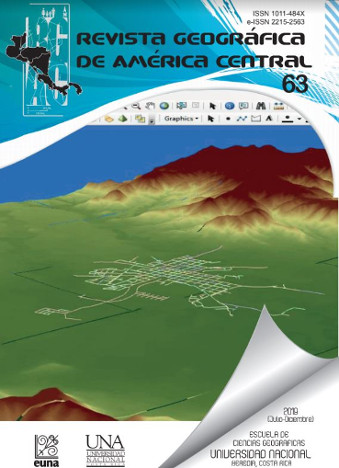Survey of physical-chemical aspects of mindu microbacy waters in Manaus-Amazonas
DOI:
https://doi.org/10.15359/rgac.63-2.13Keywords:
Igarapé; Mindu; degradation; basinAbstract
The Mindu microbasin, the main tributary of the São Raimundo basin drains part of the urban waters of the city of Manaus-AM to one of the largest rivers in the world, the Rio Negro. The Mindu stream, commonly called in the region by igarapé by virtue of its narrow channel, presents itself under a great threat of degradation of its waters. The great pollution and contamination of the water is characterized by the contribution of domestic and industrial waste, silting of its bed and release of solid waste on the bed of the stream. The following parameters were analyzed: pH, electrical conductivity, dissolved oxygen, turbidity, temperature, and total dissolved solids, with the aid of a multiparameter probe at 11 points, to evaluate the physico-chemical characteristics of the water quality of the Mindu microbasin. of the main channel of the Mindu stream. Sulphide, ammoniacal nitrogen, and total phosphate analyzes were performed in the laboratory. The results showed that the stream has a slightly acidic pH at the point near the springs and it is sensible alkaline in the other stretches, dissolved oxygen content below that stipulated for the legislation, characterization of dissolved and suspended solids that contribute to high concentrations of electrical conductivity, turbidity, and total dissolved solids. The analyzed sections were still influenced by the contribution of domestic and industrial effluents with the characterization of sulfides, phosphorus in the form of phosphates and nitrogen in the form of ammoniacal nitrogen dissolved in the waters.
References
Agência Nacional de Águas (2012). Panorama da Qualidade das Águas Superficiais do Brasil. Disponível em: <http://ana.gov.br>.
Almeida, F.R; Leite, J.C; Alves, C.N; Deus, R.J.A. (2017). Environmental diagnostic of the spa park 10 de Novembro at Igarapé Mindú in Manaus. ITEGAM-JETIA, v.3, n°10, pp.204-219.
APHA (2005). American Public Health Association. Standard methods for the examination of water and wastewater, 21st ed. Washington.
Borges, M. G. M. e Santos, E. C. (2011). Gestão ambiental e preservação de nascentes: um estudo para elaboração de políticas de gestão ambiental da nascente do Igarapé do Mindú, no bairro Cidade de Deus – Manaus/AM. Revista Geográfica de América Central, Número Especial EGAL, Costa Rica, 2 (47E), pp.1-12.
Brasil (2005). Resolução CONAMA n° 357/2005 "Dispõe sobre a classificação dos corpos de água e diretrizes ambientais para o seu enquadramento, bem como estabelece as condições e padrões de lançamento de efluentes, e dá outras providências."- Data da legislação: 17/03/2005 - Publicação DOU: 18/03/2005.
Cassiano, K, R, M. (2013). Análise Geográfica de Áreas de Risco na Bacia Hidrográfica do Igarapé do Mindu – Manaus (AM). Dissertação do Mestrado em Geografia. Universidade Federal de Santa Catarina, Florianópolis-SC. 103p.
CETESB. (2011). Companhia de Tecnologia de Saneamento Ambiental. Resolução n° 724/2011 -Guia Nacional de coleta e preservação de amostras: água, sedimentos, comunidades aquáticas e efluentes líquidos. São Paulo: CETESB: Brasília: ANA.
Diego, O.S; Nascimento, M.G; Alvalá, R.C.S; (2015). Influência do crescimento urbano sobre o microclima de Manaus e Belém: Um estudo observacional. Revista Brasileira de Geografia Física, v.8, n°4, pp.1109-1124.
Fernandes, E.P; Stehlgens, L.S; Santos, S.O.; Chaves, E.V. (2016). Avaliação do Comportamento Hidroquímico de Fosfato das Águas do Igarapé da Bacia do Educandos no Município de Manaus. Anais do I Congresso de Ciência, Educação e Pesquisa Tecnológica. IFAM/CONCEPT, Manaus-AM.
Ferreira, S.J.F.; Miranda, S.A.F.; Silva, C.C; Marques Filho, A.O; (2012). Efeito da pressão antrópica sobre igarapés na Reserva Florestal Adolpho Ducke, área de floresta na Amazônia Central. Acta Amazônica, v.42, n°4, pp.533-540.
INSTITUTO TRATA BRASIL; (2018). Ranking do Saneamento 2018. São Paulo-SP, 118p.
MELO, E. G. F.; SILVA, M. S. R.; MIRANDA, S. A. F. Influência antrópica sobre águas de igarapés na cidade de Manaus-Amazonas. Caminhos de geografia, v.5, n°16, pp.40-47, 2005.
Nascimento, J.H.P. Efeitos e exposição de ovos e larvas de Osteocephalus taurinus Steindachner, 1862 – (Anura, Hylidae) à água contaminada de dois igarapés de Manaus-AM: Toxidade aguda e crônica. Dissertação de Mestrado. Manaus-AM: Ufam, 45p, 2011.
Pinto, A. G. N.; Horbe, A.M.C.; Silva, M.S.R.; Miranda, S.A.F.; Pascoaloto, D.; Santos, H.M.C. (2009). Efeitos da ação antrópica sobre a hidrogeoquímica do rio Negro na orla de Manaus/AM. Acta Amazônica, v.39, n°3, pp.627-638.
Prefeitura Municipal de Manaus (2006). Decreto municipal N° 8.351, de 17 de março de 2006. Institui o Parque Municipal Nascentes (PMNM), Centro de Vigilância da Nascente.
Prefeitura Municipal de Manaus (2008) Plano de Manejo do Corredor Ecológico Urbano do Igarapé do Mindu/Parque Municipal do Mindu. Manaus.
Prefeitura Municipal de Manaus. (1993). Lei municipal N° 219, novembro de 1993. Criação do Parque Municipal do Mindu.
Sperling, M. V. (2005). Introdução à qualidade da água e ao tratamento de esgoto. Belo Horizonte. Ed. DESA/UFMG, pp. 452.
SIOLI, H.; KLINGE, H. Solos, tipos de vegetação e águas na Amazônia. Boletim geográfico. v.79, pp.27-41, 1962.
Downloads
Published
How to Cite
Issue
Section
License
Proposed policy for journals offering Open Access
Authors publishing their works in the Journal acknowledge and agree to the following terms:
a) Authors retain the copyrights to their works and guarantee the Journal the right to be the first to publish their works, under the Creative Commons License Attribution-NonCommercial-ShareAlike 4.0 International, CC BY-NC-SA 4.0 International (https://creativecommons.org/licenses/by-nc-sa/4.0/deed.es), which allows others to share works upon complying with the acknowledgment of authorship and mention of the Journal as the original publisher of the work.
b) Authors are permitted to separately establish additional agreements for the non-exclusive distribution of the official edition of the work published in the Journal (for example, authors may desire to place the work in an institutional repository or incorporate it into a book that is to published elsewhere) so long they acknowledgment to recognize the Journal as the original publisher. The aforementioned additional agreements must respect the terms of the non-profit character and sharing philosophy of the original license (CC BY-NC-SA 4.0 International, https://creativecommons.org/licenses/by-nc-sa/4.0/deed.es).
c) Authors are encouraged to archive the post-print or editor/PDF version in Open Access repositories.






 REVGEO is licensed under https://creativecommons.org/licenses/by-nc-sa/4.0/deed.es
REVGEO is licensed under https://creativecommons.org/licenses/by-nc-sa/4.0/deed.es
.svg_4.png)

_(1).png)
_(1)_(1)_(1)_1.png)
(2)(1)(1)(1).png)
